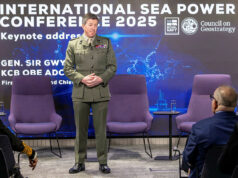British F-35 Lightning jets, supported by Royal Air Force RC-135 Rivet Joint intelligence gathering aircraft and Voyager tankers, joined forces with their Norwegian and U.S. counterparts for a live fire exercise on Norway’s northern coast.
The training event showcased the interoperability of NATO forces, with precision weapon drops targeting simulated enemy positions and collaborative efforts to strengthen NATO’s northern defence.
The exercise, involving F-35 aircraft from the Royal Norwegian Air Force, U.S. Air Force, and RAF, utilised advanced data-sharing capabilities to establish a unified airspace picture. This enabled the seamless execution of “find, fix, track, and target” (F2T2) procedures, culminating in U.S. Air Force B-52 Stratofortress bombers successfully striking a simulated target.
Group Captain Bishop, Head of Operational Plans for the RAF, highlighted the significance of the exercise, stating:
“Interoperability is vital to the defence of NATO’s northern flank. This exercise has demonstrated important enduring strengths of our alliance: our ability to understand how each other operates, to share critical information quickly, and to work seamlessly with each other.”
The Arctic region’s strategic importance was underscored by U.S. Air Force Europe and Africa Commander General Hecker, who noted:
“The Arctic is a critical region for our collective security and global stability. Training with our Norwegian and UK Allies in this environment demonstrates our shared commitment to defending NATO’s northern flank and adapting to emerging threats.”
RAF assets included the RC-135 Rivet Joint, which provided electronic surveillance to enhance the intelligence picture, and a Voyager tanker from RAF Brize Norton, ensuring aircraft remained airborne without requiring ground refuelling.
The exercise also reinforced the Joint Expeditionary Force’s role, comprising the UK, Norway, and eight other northern European nations, as a rapid-response force capable of multi-domain operations.
Brigadier General Tron Strand of Norway emphasised the value of such collaboration:
“This training event demonstrates the ability of the Norwegian Armed Forces to integrate with and leverage cutting-edge capabilities provided by the UK and US in multi-domain operations. Together we are a credible deterrent, and if required, we are ready to defend the Arctic region.”













